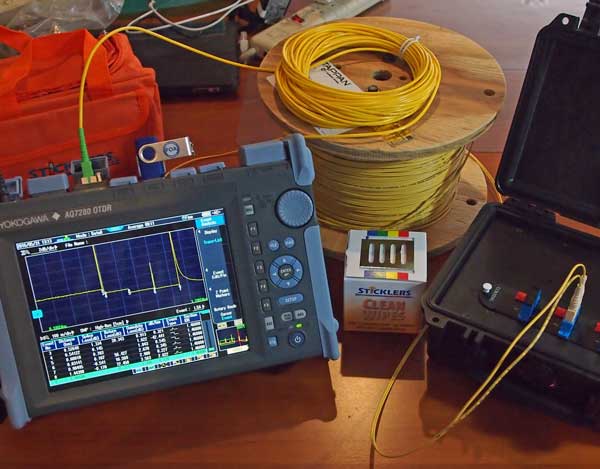Robotic vision enables optimizing manufacturing and quality control.
Discovering the Benefits of Optical Fiber Checking for Boosted Communication Systems
The importance of optical fibre testing in modern communication systems can not be overstated, as it serves as a foundation for ensuring network integrity and performance. This positive screening strategy has profound ramifications for signal high quality and functional efficiency, increasing the inquiry of how these methods add to long-term sustainability in an ever-evolving technological landscape.
Relevance of Optical Fibre Testing
The relevance of optical fibre screening can not be overemphasized in today's data-driven environment. As organizations progressively count on high-speed data transmission for daily operations, the honesty and performance of optical fibre networks are paramount. Testing makes sure that these networks can support the large amounts of data created and sent seamlessly, cultivating reliable communication and connection.
Optical fibre testing serves several important functions, consisting of validating installation quality, recognizing prospective faults, and determining overall system efficiency. Routine screening can stop expensive downtimes and service disruptions, allowing companies to keep functional connection. It assists in conformity with sector standards and regulations, guaranteeing that fiber optic setups satisfy called for requirements for security and integrity.
In addition, testing can improve the longevity of fiber optic systems. By proactively determining problems such as signal loss, attenuation, or adapter failures, organizations can resolve issues before they rise, therefore expanding the life of their infrastructure. In summary, optical fibre testing is not just a technological requirement yet a tactical financial investment that boosts network reliability, enhances performance, and ultimately sustains the growth and efficiency of contemporary communication systems.
Key Examining Methods

OTDR is an essential technique utilized to determine mistakes, procedure splice losses, and analyze the general stability of a fiber optic web link. By sending a pulse of light down the fibre and assessing the reflected light, service technicians can determine locations of faults and assess the network's efficiency over fars away.
Insertion loss testing determines the amount of signal loss that happens when light passes through a connection or splice. This method is vital for confirming that connections fulfill specified loss thresholds, which is necessary for keeping ideal efficiency in interaction systems.
Optical return loss testing measures the quantity of light showed back in the direction of the source because of flaws in the fibre or connections. High return loss worths suggest much better efficiency and reduced signal deterioration.
With each other, these screening techniques give a comprehensive analysis of fibre optic networks, guaranteeing their dependability and capability in visit this page varied interaction applications.
Influence On System Efficiency
Efficient optical fiber testing directly influences the total efficiency of interaction systems. By ensuring the stability of fiber optic cords, testing identifies possible mistakes such as attenuation, splice loss, and connector misalignment. These issues can dramatically degrade signal top quality, bring about disturbances and reduced information transmission rates.

Additionally, normal optical fiber testing adds to lasting system sustainability. It enables very early detection of deterioration, allowing for prompt maintenance and upgrades prior to major failings take place. This not only prolongs the life expectancy of the infrastructure but additionally makes sure that communication systems remain affordable in regards to performance.
Cost-Effectiveness and Performance
Cost-effectiveness is an essential consideration in the release and upkeep of optical fibre networks. Carrying out robust optical fibre testing treatments can dramatically decrease functional prices by determining concerns before they intensify right into major troubles. optical fibre diameter analyser. By detecting faults, depletion, and various other performance barriers early, organizations can avoid expensive fixings and downtime, which can disrupt services and bring about earnings loss
Furthermore, effective screening methodologies simplify the installment process, allowing technicians to function a lot more successfully. This translates to decrease work costs and faster task conclusion times. Advanced screening devices, such his comment is here as Optical Time Domain Reflectometers (OTDRs), allows an exact assessment of fibre top quality, making sure that only optimum materials are made use of, thus lessening waste.
Regular testing also adds to far better resource allowance. By recognizing the network's efficiency, companies can make enlightened decisions concerning upgrades and growths, making certain that investments are made where they are most required. In summary, optical fiber testing improves cost-effectiveness and effectiveness, sustaining the lasting sustainability and competition of interaction systems in an increasingly requiring market.
Guaranteeing Long-Term Reliability
Applying extensive optical fiber testing not just enhances expense financial savings and functional effectiveness yet likewise plays a crucial role in making certain the long-lasting reliability of communication networks. Constant testing techniques, consisting of attenuation and transmission capacity analyses, aid recognize possible degradation in fiber efficiency prior to it causes solution disruptions.
By using sophisticated testing methods, network operators can determine faults or weak points in the fibre infrastructure, permitting prompt remediation. This positive approach minimizes downtime, ensuring that interaction systems remain useful and effective. Additionally, regular screening adds to the growth of a much more resilient network, as operators can adapt and optimize their facilities based on real-time information understandings. robotic vision.
In addition, making certain compliance with sector standards via optical fiber screening enhances the high quality and integrity of the whole communication system. This adherence not only bolsters confidence amongst stakeholders but also lines up with regulative demands, which are increasingly strict.
Conclusion
In final thought, optical fiber testing serves as an essential imp source part in boosting interaction systems. By using various screening techniques, such as OTDR and insertion loss assessments, networks can attain ideal performance and reliability.